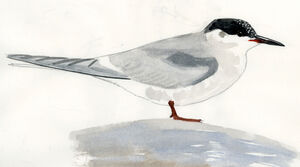Arctic Tern
Sterna paradisaea - Sterne arctique
Identification
It is a bird very close to the little tern and its differentiation is particularly difficult except in good observation conditions. However, some morphological criteria allow for its distinction, particularly its more compact general silhouette due to its smaller and rounder head, its shorter beak, its somewhat elongated body disposed on extremely modest feet. For the nuptial adult, it is nonetheless the physical details that allow for the difference: longer tail streamers, barely passing the end of the wing when laid down, shorter beak and feet of a darker red, and especially an underside typically grayer than most little terns. A few last details come to confirm the distinction. For the Arctic Tern, the side faces of the head and the cheeks are whiter, the black cap descends less widely on the nape, the primary remiges do not bear the dark marks of wear that can be seen on its little tern counterpart. In winter plumage, the Arctic Tern undergoes three minor transformations: the forehead whitens, the color of the beak becomes black and the streamers of the tail are shorter.
Subspecific information monotypic species
Foreign names
- Sterne arctique,
- Charrán ártico,
- gaivina-do-ártico,
- Küstenseeschwalbe,
- sarki csér,
- Noordse Stern,
- Sterna codalunga,
- silvertärna,
- Rødnebbterne,
- rybár dlhochvostý,
- rybák dlouhoocasý,
- Havterne,
- lapintiira,
- Arktiese Seeswael (Arktiese Sterretjie),
- xatrac àrtic,
- Kría,
- rybitwa popielata,
- jūras zīriņš,
- polarna čigra,
- Полярная крачка,
- キョクアジサシ,
- 北极燕鸥,
- silvertärna,
- 北極燕鷗,
Habitat
In summer, the Arctic Tern exclusively frequents coastal habitats in the Northern Hemisphere and subantarctic zone in winter. It can be seen on our coasts during its main passage along the Atlantic coast at the end of summer. It nests on low coastal islands or islets. On its way, it can be found along the coast or inland, only in very exceptional weather conditions, especially during storms. It also occasionally nests in France.
Behaviour character trait
Gulls and seagulls often nest in company with Arctic Terns, taking advantage of their efficient protection against predators.
A Tern colony is indeed always on watch with a sentinel. Upon its signal, all Terns take off and vigorously attack the intruder. As its name suggests, the Arctic Tern spends summer in the northern hemisphere, near the Arctic. Then it flies south, crossing broad oceanic areas to over winter in Southern Africa, Australia and Antarctica. The species makes the journey in approximately four months and its round trip may cover 35,000 kilometers. The Arctic Tern's migratory route follows the water, allowing it to feed throughout the journey. By flying from one pole to the other, the Arctic Tern takes advantage of more hours of daylight than any other bird; allowing it to eat longer and to exploit food sources where they are abundant.Dietfeeding habits
The Arctic Tern mostly feeds on small fish, but also on plankton and small crustaceans. This marine diet allows it to keep feeding during long migrations.
The tern hovers above the water, then plunges and catches fish with its beak, holding them just behind the gills. This fishing technique is typical of most terns. It was calculated that one out of every three plunges was successful. When it fails, the Arctic Tern does not pursue the fish underwater, but immediately returns to the surface. Like gulls and gannets, the Arctic Tern recognizes the white flashes of the plumage of other birds diving, so that it can locate fish schools.Reproduction nesting
Although they spend most of the year apart, Arctic Tern couples are united for life and each Spring return to the same place to mate and nest.
The species nests in large colonies on sandy or pebbly beaches and among rocks close to the sea. The male performs an elaborate nuptial display, particularly when looking for a mate for the first time. Once a partner has been selected, the male flies very high in the sky and the female follows him. The couple glide together, then swoop in zigzags and continue their display on the ground. The male offers the female fish and circles her with his tail spread and wings drooping, often with a fish in his beak. The couple build their nest on the ground, scraping a hollow which both male and female line with a few plants. The female normally lays two buff or cream eggs spotted with brown and black. Males and females incubate the eggs for 20 to 24 days. Covered in down feathers, the chicks are quick to become active but remain close to the nest. The Arctic Tern fiercely defends its nest and young, delivering hard strikes to any intruder who comes close. The chicks take flight between 21 and 24 days after hatching but are fed by their parents for several more weeks, before learning to hunt for themselves. Young Arctic Terns migrate in their first year, but don't breed until 3 or 4 years old.Threats - protection
Sources of information
- IOC World Bird List (v15.1), Gill, F and D Donsker (Eds). 2025-12-07.
Other sources of interest
 Specification sheet created on
28/10/2023 by Didier Collin with help of Daniel Le-Dantec and Georges Olioso
Specification sheet created on
28/10/2023 by Didier Collin with help of Daniel Le-Dantec and Georges OliosoTranslation by AI Oiseaux.net
© 1996-2025 Oiseaux.net
- Accipitriformes
- Aegotheliformes
- Anseriformes
- Apodiformes
- Apterygiformes
- Bucerotiformes
- Caprimulgiformes
- Cariamiformes
- Casuariiformes
- Charadriiformes
- Ciconiiformes
- Coliiformes
- Columbiformes
- Coraciiformes
- Cuculiformes
- Eurypygiformes
- Falconiformes
- Galliformes
- Gaviiformes
- Gruiformes
- Leptosomiformes
- Mesitornithiformes
- Musophagiformes
- Nyctibiiformes
- Opisthocomiformes
- Otidiformes
- Passeriformes
- Pelecaniformes
- Phaethontiformes
- Phoenicopteriformes
- Piciformes
- Podargiformes
- Podicipediformes
- Procellariiformes
- Psittaciformes
- Pterocliformes
- Rheiformes
- Sphenisciformes
- Steatornithiformes
- Strigiformes
- Struthioniformes
- Suliformes
- Tinamiformes
- Trogoniformes































